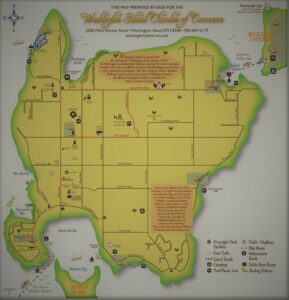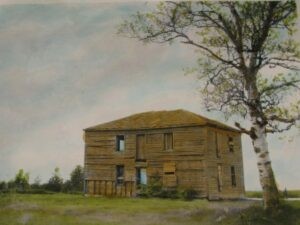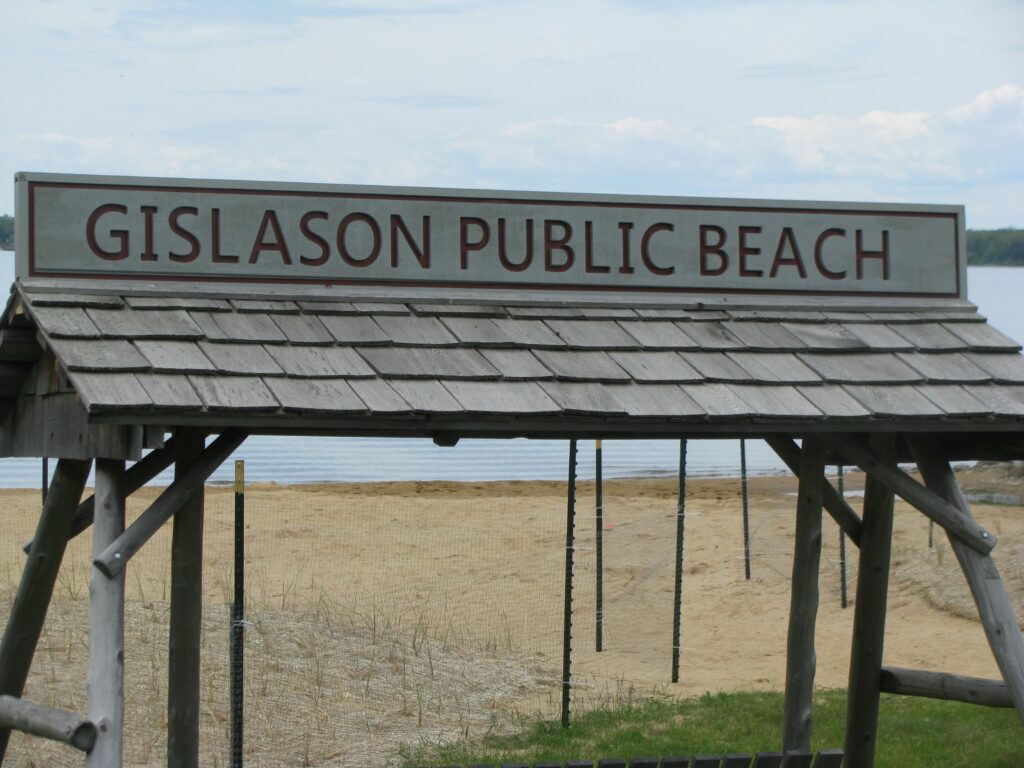
Washington Island is a relatively small island about 10 km (6 miles) northeast of the “Door Peninsula” that juts out into Lake Michigan from Wisconsin. The island is about 8 km (5 miles) wide and 10 km (6 miles) long or just over 60 square kilometers (37 square miles), but other islands nearby are considerably smaller. French explorers called the strait between the island and the mainland “Death’s Door” because many ships and boats had perished in severe storms on the strait. Indigenous peoples had been on the islands on the lake during the summer, but the oldest known name for Washington Island, “Wassekiganeso”, is from the Ojibwa language and means “his breast shines” and is drawn from sunlight reflected by the light sandstone belt on the island. Another name that stuck longer, 1650-1816, was Potawatomi Island, derived from the name of the Potawatomi people, who settled on the islands. Other names are known such as Huron Island and Noquet Island. It was in the summer of 1816 that John Miller, commander of the United States Army, led a fleet of several ships from Green Bay, sailed out of the bay and into the lake. His ship, Washington, was the largest and fastest, so while he waited for the others in a bay on the island, the bay was named Washington Harbor after the president and is still called that. The crew took the opportunity to explore the island, saw other smaller ones and gave them names. When the American Civil War ended in 1865, fishermen began to make regular visits to the island, building huts and spending the summer. Around 1870, settlement began, a few German, Norwegian and Danish settlers arrived, chose land and began to cut down trees and shrubs so that farming could begin. This was the situation in late summer when Jón Gíslason and Wilhelm Wickmann moved there and bought land.

This house is called “Icelandic Castle” or Íslenski kastalinn on Washington Island. New Icelandic arrivals stayed there for some time while becoming established. Photo: WIA
Icelandic settlement: Wilhelm Wickmann was born in Copenhagen in 1834 and grew up there. He received education and worked there, which led to a trip to Iceland. The author (JÞ) does not know what year he sailed, but in 1857 Fritz William Virkmann is a registered assistant in Guðmundur Thorgrimsen’s store in Eyrarbakki and it must be assumed that it is one and the same man. He was in Eyrarbakki until 1864, his name changes a bit during the period because he is registered as Fritz Wichmann in 1862 and Fritz Vichmann in 1864. He probably sailed for Denmark that year to prepare for a journey west to his sister who lived in Wisconsin and arrived in Milwaukee in April, 1865. He was obviously friends with Guðmundur, who he later said was especially well-regarded throughout the south in Iceland. Guðmundur had probably been interested in Wilhelm’s plans to move west across the ocean and requested information from him. Wilhelm sends descriptions of what he saw and what he read and got to know. Wickmann’s letters were read in Eyrarbakki and obviously played a part in the fact that on May 12, 1870, three young men set off for Reykjavík, where the mail ship Díana was in port, but it was on its way to Copenhagen. These three young men were Jón Gíslason, Guðmundur Guðmundsson and Árni Guðmundsson. In Reykjavík, Jón Einarsson joined the group. (See more about them). They left the port on June 3, sailed to Quebec and then by train to Milwaukee, where they arrived on June 27. Wickmann waited for them there and put them to work: two of them fishing, and the other two with farmers near the city, but in the fall they all went to Washington Island. There, Wickmann and Jón Gíslason bought land from an Irishman for $400 dollars that had a 1,500-foot beach in Detroit Harbor. The four immigrants settled down and were on the island during the winter. In the following years, the number of Icelanders gradually increased, but there was never an Icelandic colony there, at its peak (around 1900) 25 Icelandic settlers had settled there and 20 of them were permanent residents. Of these 20, 14 were engaged in farming, others in fishing, trade and blacksmithing. What characterizes this Icelandic settlement is first and foremost is peace and harmony with settlers of other origins. The Icelanders were too few to form a congregation, instead they were members of the “Scandinavian Lutheran Congregation”. No experiment was made with an Icelandic newspaper or Icelandic society of any kind. It was clear from the beginning that Icelanders agreed to be participants in the formation of a larger society, the American people. Laws and regulations followed American regulations, the administration of public affairs on the island was in the hands of investors from New York until 1875, when a local government was elected that consisted mostly of Danish and Norwegian immigrants, Jón Gíslason was the only Icelander. Wilhelm Wickmann was then appointed mayor and was re-appointed a year later.
English version by Thor Group

Jón Gíslason was successful on Washington Island and was highly regarded by all citizens. The photo shows part of the beach he and Wickmann bought in 1870. Photo: JT
